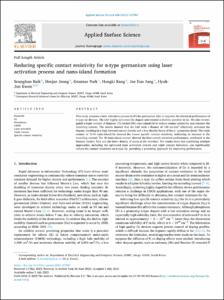Department of Electrical Engineering and Computer Science
Advanced Electronic Devices Research Group(AEDRG) - Kang Lab.
1. Journal Articles
Full metadata record
| DC Field | Value | Language |
|---|---|---|
| dc.contributor.author | Baik, Seunghun | - |
| dc.contributor.author | Jeong, Heejae | - |
| dc.contributor.author | Park, Geuntae | - |
| dc.contributor.author | Kang, Hongki | - |
| dc.contributor.author | Jang, Jae Eun | - |
| dc.contributor.author | Kwon, Hyuk-Jun | - |
| dc.date.accessioned | 2023-08-28T16:10:26Z | - |
| dc.date.available | 2023-08-28T16:10:26Z | - |
| dc.date.created | 2023-07-08 | - |
| dc.date.issued | 2023-11 | - |
| dc.identifier.issn | 0169-4332 | - |
| dc.identifier.uri | http://hdl.handle.net/20.500.11750/46329 | - |
| dc.description.abstract | This study presents a laser activation process (LAP) for germanium (Ge) to improve the electrical performance of n-type Ge devices. The LAP highly activated the dopant and created a shallow junction in Ge. We also investigated a triple contact of titanium (Ti)/nickel (Ni) nano-island/Ge to reduce contact resistivity and enhance the tunneling current. The results showed that the LAP with a fluence of 140 mJ/cm2 effectively activated the dopant, resulting in a high forward current density and a low ideality factor of the n+-p junction diode. The triple contact of Ti/Ni nano-island/Ge showed the lowest specific contact resistivity, indicating an increase in the tunneling current. The Ni nano-island contact showed the best overall electrical performance, attributed to the boosted electric field and the lower density of states at the interface. The results show that combining multiple approaches, including the optimized laser activation process and triple contact formation, can significantly reduce the contact resistance on n-type Ge, providing a promising approach for improving performance. | - |
| dc.language | English | - |
| dc.publisher | Elsevier BV | - |
| dc.title | Reducing Specific Contact Resistivity for n-type Germanium using Laser Activation Process and Nano-island Formation | - |
| dc.type | Article | - |
| dc.identifier.doi | 10.1016/j.apsusc.2023.157967 | - |
| dc.identifier.wosid | 001043810700001 | - |
| dc.identifier.scopusid | 2-s2.0-85165411804 | - |
| dc.identifier.bibliographicCitation | Applied Surface Science, v.638 | - |
| dc.description.isOpenAccess | TRUE | - |
| dc.subject.keywordAuthor | Ge | - |
| dc.subject.keywordAuthor | Phosphorus | - |
| dc.subject.keywordAuthor | CMOS | - |
| dc.subject.keywordAuthor | Laser activation | - |
| dc.subject.keywordAuthor | Triple contact | - |
| dc.subject.keywordAuthor | Specific contact resistivity | - |
| dc.subject.keywordPlus | SHALLOW JUNCTION FORMATION | - |
| dc.subject.keywordPlus | PHOSPHORUS DIFFUSION | - |
| dc.subject.keywordPlus | DOPING PROCESS | - |
| dc.subject.keywordPlus | GATE-STACK | - |
| dc.subject.keywordPlus | GE | - |
| dc.subject.keywordPlus | IMPLANTATION | - |
| dc.subject.keywordPlus | EXTRACTION | - |
| dc.subject.keywordPlus | RESISTANCE | - |
| dc.subject.keywordPlus | INTERFACE | - |
| dc.subject.keywordPlus | TITANIUM | - |
| dc.citation.title | Applied Surface Science | - |
| dc.citation.volume | 638 | - |
| dc.description.journalRegisteredClass | scie | - |
| dc.description.journalRegisteredClass | scopus | - |
| dc.relation.journalResearchArea | Chemistry; Materials Science; Physics | - |
| dc.relation.journalWebOfScienceCategory | Chemistry, Physical; Materials Science, Coatings & Films; Physics, Applied; Physics, Condensed Matter | - |
| dc.type.docType | Article | - |
- Files in This Item:
-
 기타 데이터 / 4.35 MB / Adobe PDF
download
기타 데이터 / 4.35 MB / Adobe PDF
download
- Appears in Collections:
- Department of Electrical Engineering and Computer Science Advanced Electronic Devices Research Group(AEDRG) - Kwon Lab. 1. Journal Articles
- Department of Electrical Engineering and Computer Science Advanced Electronic Devices Research Group(AEDRG) - Jang Lab. 1. Journal Articles
- Department of Electrical Engineering and Computer Science Advanced Electronic Devices Research Group(AEDRG) - Kang Lab. 1. Journal Articles



